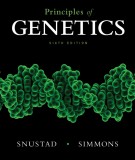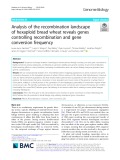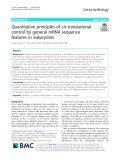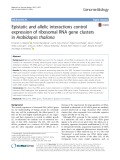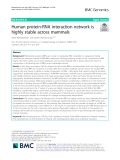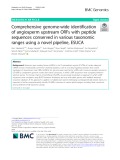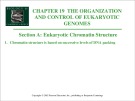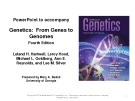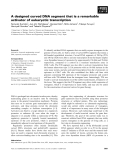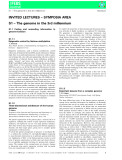
Control of eukaryotic genomes
-
Ebook "Untranslated gene regions and other non-coding elements: Regulation of eukaryotic gene expression" pervasive transcription of complex genomes produces a variety of non-coding transcripts that interact with these regions and contribute to regulation. This book discusses recent insights into the regulatory roles of the untranslated gene regions and non-coding RNAs in the control of complex gene expression, as well as the implications of this in terms of organism complexity and evolution.
 63p
63p  manmanthanhla0201
manmanthanhla0201
 26-02-2024
26-02-2024
 5
5
 1
1
 Download
Download
-
Continued part 1, part 2 of ebook "Principles of Genetics (Sixth edition)" provide readers with content about: the techniques of molecular genetics; genomics; applications of molecular genetics; transposable genetic elements; regulation of gene expression in prokaryotes; regulation of gene expression in eukaryotes; the genetic control of animal development; the genetic basis of cancer; inheritance of complex traits;...
 402p
402p  hanlinhchi
hanlinhchi
 11-11-2022
11-11-2022
 106
106
 3
3
 Download
Download
-
Sequence exchange between homologous chromosomes through crossing over and gene conversion is highly conserved among eukaryotes, contributing to genome stability and genetic diversity. A lack of recombination limits breeding efforts in crops; therefore, increasing recombination rates can reduce linkage drag and generate new genetic combinations.
 16p
16p  vigalileogalilei
vigalileogalilei
 27-02-2022
27-02-2022
 11
11
 1
1
 Download
Download
-
Quantitative principles of cis-translational control by general mRNA sequence features in eukaryotes
General translational cis-elements are present in the mRNAs of all genes and affect the recruitment, assembly, and progress of preinitiation complexes and the ribosome under many physiological states. These elements include mRNA folding, upstream open reading frames, specific nucleotides flanking the initiating AUG codon, protein coding sequence length, and codon usage.
 24p
24p  vielonmusk
vielonmusk
 30-01-2022
30-01-2022
 16
16
 2
2
 Download
Download
-
Ribosomal RNA (rRNA) accounts for the majority of the RNA in eukaryotic cells, and is encoded by hundreds to thousands of nearly identical gene copies, only a subset of which are active at any given time. In Arabidopsis thaliana, 45S rRNA genes are found in two large ribosomal DNA (rDNA) clusters and little is known about the contribution of each to the overall transcription pattern in the species.
 15p
15p  vialfrednobel
vialfrednobel
 29-01-2022
29-01-2022
 15
15
 0
0
 Download
Download
-
Post-transcriptional regulation is crucial for the control of eukaryotic gene expression and might contribute to adaptive divergence. The three prime untranslated regions (3’ UTRs), that are located downstream of protein-coding sequences, play important roles in post-transcriptional regulation. These regions contain functional elements that influence the fate of mRNAs and could be exceptionally important in groups such as rapidly evolving cichlid fishes.
 11p
11p  vibeauty
vibeauty
 23-10-2021
23-10-2021
 13
13
 1
1
 Download
Download
-
RNA-binding proteins (RBPs) are crucial in modulating RNA metabolism in eukaryotes thereby controlling an extensive network of RBP-RNA interactions. Although previous studies on the conservation of RBP targets have been carried out in lower eukaryotes such as yeast, relativ
 14p
14p  vijeeni2711
vijeeni2711
 24-07-2021
24-07-2021
 6
6
 0
0
 Download
Download
-
Upstream open reading frames (uORFs) in the 5′-untranslated regions (5′-UTRs) of certain eukaryotic mRNAs encode evolutionarily conserved functional peptides, such as cis-acting regulatory peptides that control translation of downstream main ORFs (mORFs).
 16p
16p  vijeeni2711
vijeeni2711
 24-07-2021
24-07-2021
 13
13
 0
0
 Download
Download
-
Chapter 19 - The organization and control of eukaryotic genomes. After reading this chapter and attending lecture, the student should be able to: Compare the organization of prokaryotic and eukaryotic genomes, describe the current model for progressive levels of DNA packing, explain how histones influence folding in eukaryotic DNA,...
 74p
74p  tradaviahe19
tradaviahe19
 29-03-2021
29-03-2021
 10
10
 1
1
 Download
Download
-
Miniature inverted-repeat transposable elements (MITEs) are short, non-autonomous class II transposable elements present in a high number of conserved copies in eukaryote genomes. An accurate identification of these elements can help to shed light on the mechanisms controlling genome evolution and gene regulation.
 10p
10p  viconnecticut2711
viconnecticut2711
 28-10-2020
28-10-2020
 21
21
 1
1
 Download
Download
-
Heat shock transcription factors (Hsfs), which act as important transcriptional regulatory proteins in eukaryotes, play a central role in controlling the expression of heat-responsive genes.
 16p
16p  viminato2711
viminato2711
 22-05-2020
22-05-2020
 14
14
 0
0
 Download
Download
-
(bq) part 2 book "snustad principles of genetics" presents the following contents: the techniques of molecular genetics, genomics, applications of molecular genetics, transposable genetic elements, regulation of gene expression in eukaryotes, the genetic control of animal development, population genetics, evolutionary genetics,...
 402p
402p  thangnamvoiva6
thangnamvoiva6
 19-07-2016
19-07-2016
 61
61
 12
12
 Download
Download
-
Chapter 16 - Gene regulation in eukaryotes. The main contents of this chapter include all of the following: Overview of eukaryotic gene regulation, control of transcription initiation, chromatin structure and epigenetic effects, regulation after transcription, a comprehensive example: sex determination in Drosophila.
 65p
65p  tangtuy04
tangtuy04
 12-03-2016
12-03-2016
 61
61
 3
3
 Download
Download
-
To identify artificial DNA segments that can stably express transgenes in the genome of host cells, we built a series of curved DNA segments that mimic a left-handed superhelical structure. Curved DNA segments of 288 bp (T32) and 180 bp (T20) were able to activate transcription from the herpes simplex virus thymidine kinase (tk) promoter by approximately 150-fold and 70-fold, respectively, compared to a control in a transient transfection assay in COS-7 cells.
 12p
12p  inspiron33
inspiron33
 23-03-2013
23-03-2013
 41
41
 2
2
 Download
Download
-
Epigenetic mechanisms, such as histone modifications, control eukaryotic development beyond DNA-stored information. Intrigu-ingly, there is an under-representation of repressive marks in quies-cent (resting) cells, stem cells and regenerating cells, but a selective accumulation of aberrant histone lysine methylation profiles in aging, ‘‘stressed’’ and tumor cells, particularly for the H3K9, H3K27 and H4K20 methyl marks.
 65p
65p  cosis54
cosis54
 05-01-2013
05-01-2013
 50
50
 3
3
 Download
Download
-
DNA replication, the process of copying one double stranded DNA molecule to produce two identical copies, is at the heart of cell proliferation. This book highlights new insights into the replication process in eukaryotes, from the assembly of pre-replication complex and features of DNA replication origins, through polymerization mechanisms, to propagation of epigenetic states. It also covers cell cycle control of replication initiation and includes the latest on mechanisms of replication in prokaryotes. The association between genome replication and transcription is also addressed.
 318p
318p  camchuong_1
camchuong_1
 04-12-2012
04-12-2012
 67
67
 9
9
 Download
Download
-
Methylation was initially addressed as one of the most primitive mechanisms that organisms utilize to (a) protect genomic DNA and initiate the host resistance mechanism towards foreign DNA insertion and subsequently, (b) control gene expression, (Doerfler & Böhm, 2006). From an evolutionary point of view as well, the catalytic domain in the structure of the methylation enzymes across all organisms has been preserved to perform methyl group addition.
 226p
226p  yeutinh98
yeutinh98
 22-09-2012
22-09-2012
 73
73
 9
9
 Download
Download
CHỦ ĐỀ BẠN MUỐN TÌM









